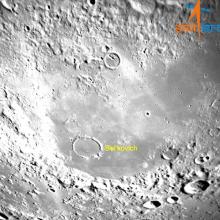Listen to today's episode of StarDate on the web the same day it airs in high-quality streaming audio without any extra ads or announcements. Choose a $8 one-month pass, or listen every day for a year for just $30.
You are here
Moon and Companions
A beautiful lineup stretches across the southeastern quadrant of the sky at first light tomorrow. It’s anchored by the crescent Moon and the nearby planet Jupiter, which looks like a brilliant star. The much-fainter planet Mars stands to their upper right, with the star Spica farther along the same line.
The Moon today is an airless world. Its only atmosphere is a few atoms, most of which were captured from the solar wind. In the distant past, though, it might have had a much thicker atmosphere — one that came from inside the Moon.
Recent research says the atmosphere was generated more than three billion years ago, when giant asteroids pummeled the lunar surface. They punched holes in the lunar crust. Molten rock oozed to the surface, creating dark volcanic plains.
This process also released a lot of gas, including water vapor. The study says these gases formed an atmosphere that was at its densest about three and a half billion years ago. At that time, it was about half again as thick as the atmosphere of present-day Mars.
Because the Moon’s gravity is weak, though, most of the air leaked out into space. But some of the water might have made its way to the Moon’s poles, where it froze inside deep craters. Those deposits could still be there, forming the layers of ice detected by orbiting spacecraft. One day, they might provide drinking water and rocket fuel for colonists — sustaining human explorers with wisps of an ancient atmosphere.
Script by Damond Benningfield





